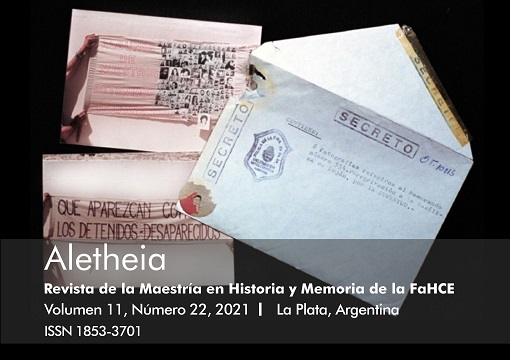Past and present of the Historical Archive of the province of Río Negro
Main Article Content
Abstract
This work seeks to reconstruct a history of the Historical Archive of the Province of Río Negro. The fifty years old trajectory of the institution reveals different vicissitudes of Rio Negro’s history. The objective of this paper is to organize periods of operation of the archive, as well as the policies that ruled it in order to understand its present. We consider that archives, far from being given and stagnant institutions, reflect power relations and political disputes around historical narratives and hegemonic identity productions. In addition, and based on the report produced by the Argentina’s General National Archive in 2017, the HAPRN contains an outstanding collection in Patagonia. However, its access and conservation conditions are at risk due to both the lack of classification and ordering and the recurring floods it suffered between 2018-2019. Faced with an imminent loss of documentary material, we ask ourselves when did the HAPRN arise and with what objectives? How was this Archive assembled, organized and created? What role did and does it have as a place of memory? To rebuild the life of the Archive, we conducted interviews and personal consultations with retired and active workers. We also resort to regulations and press articles. As well as our own experience as a worker and users -respectively- of the Archive.
Downloads
Article Details
This work is licensed under a Creative Commons Attribution 4.0 International (https://creativecommons.org/licenses/by-nc-sa/4.0/deed.es).
References
Binder, A. (2015). Del primer Congreso de Historia del Chubut y su trasfondo político y económico (Noviembre de 1967), Historia Regional, 33(12), pp. 151-169. Recuperado de: http://historiaregional.org/ojs/index.php/historiaregional/article/view/20/18
Bohoslavsky, E. y Soprano, G. (comp.) (2010). Un Estado con rostro humano. Funcionarios e instituciones estatales en Argentina (de 1880 a la actualidad). Buenos Aires: Universidad Nacional de General Sarmiento, Prometeo Libros.
Camino Vela, F. (2011). La dinámica política en la Provincia de Río Negro (Argentina) desde mediados del siglo XX: el predominio de la Unión Cívica Radical. Tesis de doctorado. Sevilla: Universidad de Sevilla.
Cecchi, P. (2018). Sobre el alma del tehuelche puso el sello el historiador. La matriz represiva y militar en la construcción de las primeras instituciones historiográficas en Viedma, Actas del Primer Congreso de Historia de la Antropología Argentina. Buenos Aires: Instituto Nacional de Antropología y Pensamiento Social, Archivo Nacional de la Memoria, pp. 121-130. Recuperado de: https://journals.openedition.org/corpusarchivos/3798?file=1
Comaroff, J. y Comaroff, J. (1992). Ethnography and the Historical Imagination. Boulder: Westview Press.
Dall’armellina, M. y Cecilia Palma, C. (2018). Caciques y colonos en los márgenes del río Negro (1850-1950). Viedma: ESFA. Recuperado de: https://caciquesycolonos.com/
Derrida, J. (1994). Mal de Archivo. Una impresión freudiana. Recuperado de: https://redaprenderycambiar.com.ar/derrida/textos/mal+de+archivo.htm
Foucault, M. (2001). La Arqueología del saber. Buenos Aires: Siglo XXI.
García, N. (2006). De la naturaleza y del origen de la “neuquinidad”. La institucionalización del pasado. Neuquén 1953-1976, Historia Regional, (24), pp. 11-27.
Heredia Herrera, A. (1986). Archivística General. Teoría y Práctica. Sevilla: Diputación Provincial.
Heredia Herrera, A. (2020). La Nueva normalidad: relaciones entre el ayer inmediato y el futuro presente, Asociación Latinoamericana de Archivos. Recuperado de: https://www.alaarchivos.org/wp-content/uploads/2020/06/Antonia-Heredia.pdf
Kropff, L., Pérez, P., Cañuqueo, L. y Wallace, J. (comps.) (2019). La tierra de los otros. La dimensión territorial del genocidio indígena y sus efectos en el presente. Viedma: Editorial UNRN.
Nazar, M. y Pak Linares, A. (2007). El hilo de Ariadna, Políticas de la Memoria, (6/7), pp. 212-218.
Palma, C. (En prensa). Políticas oficiales del recuerdo: el Centro de Investigaciones Científicas de Río Negro. En P. Pérez (comp.), El papel del Archivo. Los archivos de la nor-Patagonia. Viedma: Editorial UNRN.
Pérez Morando, H. (2005). Estudios históricos en Río Negro, Diario Río Negro, 6 de diciembre. Recuperado de: http://www1.rionegro.com.ar/arch200512/06/o06a03.php
Pérez, P. (2016). Estado, indígenas y violencia en Patagonia Central 1878-1941. Buenos Aires: Prometeo.
Pérez, P. y Delrío, W. (2019). Cambios y continuidades en las (des)territorializaciones estatales en Río Negro (1878-1955). En: L. Kropff, P. Pérez, L. Cañuqueo y J. Wallace (eds.), La tierra de los otros. La dimensión territorial del genocidio indígena y sus efectos en el presente (pp. 31-70). Viedma: Editorial UNRN.
Popular memory group (1982). Popular memory: theory politics, method. En R. Johnson, G. McLennan, B. Schwartz, y D. Sutton (eds.). Making Histories. Studies in history writing and politics (pp. 205-252). Minneapolis: University of Minnesota Press.
Trouillot, M.R. (1995). Silencing de Past. Power and the Production of History. Boston: Beacon Press.
